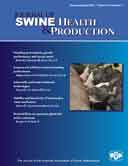Abstract:

Influence of finishing environment on pig growth performance and carcass merit
Ronald O. Bates, MS, PhD; David B. Edwards, MS, PhD; Catherine W. Ernst, MS, PhD; Matthew E. Doumit, MS, PhD; Mark D. Hoge, MS, PhD
Complete article is available online.
PDF version is available online.
Objective: To compare growth, carcass merit, and meat-quality traits for pigs of similar genetic merit finished in two different environments.
Materials and methods: Pigs (n = 973) from an F2 Duroc × Pietrain resource population were finished in either an environmentally controlled modified open-front (MOF) building or a non-environmentally controlled test station (TS) building. Serial body weight, tenth-rib backfat thickness and longissimus muscle area, and last-rib backfat thickness were collected every 3 weeks from 10 through 22 weeks of age. After slaughter, carcass, meat-quality, and eating-quality data were collected.
Results: Growth rate was not significantly different from 10 to 22 weeks of age for pigs raised in the two different finishing environments. However, pigs raised in the MOF had a greater fat accretion rate through 22 weeks of age, compared to those raised in TS. This difference persisted through harvest. After harvest, the longissimus muscle from pigs raised in the MOF had higher 45-minute pH and lower Warner-Bratzler shear-force values than loins from pigs raised in the TS.
Implications: Under the conditions of this study, finishing environment alters performance, carcass merit, and meat quality of pigs of similar genetic merit. Farms with differing types of finishing facilities should account for finishing environment in the development of their finishing management protocols. The appropriate diet formulation, ideal age and weight at marketing, and packer buying program may differ due to the impact of finishing environment on pig performance and carcass merit.
Keywords: environment, growth, meat quality
![]() Cite as: Bates RO, Edwards DB, Ernst CW, et al. Influence of finishing environment on pig growth performance and carcass merit. J Swine Health Prod 2011;19(2):86-93.
Cite as: Bates RO, Edwards DB, Ernst CW, et al. Influence of finishing environment on pig growth performance and carcass merit. J Swine Health Prod 2011;19(2):86-93.
Search the AASV web site for pages with similar keywords.
